Water in-floor heating convectors: types, installation and arrangement features
Panoramic glazing of housing is a popular fashion trend in modern renovation and construction.To heat a room with such windows, standard heating devices are not suitable, so experts have developed built-in devices for hidden installation.
They are universal water in-floor heating convectors, which are distinguished by their compactness and attractive appearance. Before deciding to use innovative equipment, you need to understand its features, don’t you agree?
The article describes in detail the various types of in-floor convectors, identifies the strengths and weaknesses of such radiators, and also provides tips on their selection and installation.
The content of the article:
- Trench convectors in the interior
- Where are built-in heating systems used?
- Types and features of equipment
- Basic requirements for the device housing
- Which type of grating do you prefer?
- Features of in-floor water devices
- Differences between radiator and electric types
- Rules for choosing a device
- Features of installation of an in-floor convector
- Advantages and disadvantages of equipment
- Conclusions and useful video on the topic
Trench convectors in the interior
The modern market offers various heating equipment, which is designed to create a comfortable and cozy atmosphere in rooms for various purposes.
In-floor models are universal devices that perform heating and decorative functions. They provide the desired temperature in an apartment or office in a short period of time.
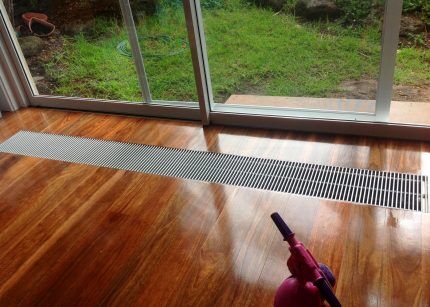
A convector connected to a water heating system or power supply is a multifunctional device that perfectly performs its direct functions and serves as interior decoration. It not only plays the role of a compact, almost invisible heating equipment, but is also a stylish addition to the design of the room.
If the apartment owner has chosen devices placed in the floor structure for heating, special niches will have to be prepared during the renovation process.
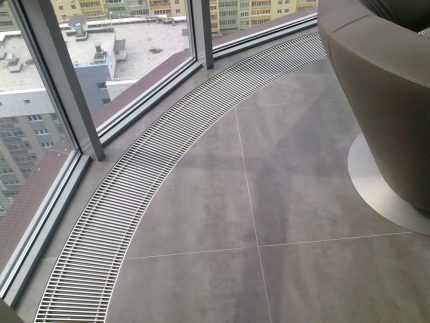
Built-in models are more attractive and efficient than conventional radiators. The latter heat the room using thermal radiation, and electric convectors and water models, in addition to radiation, also heat the air flow circulating through them.
Features of operation, as well as recommendations for choosing electric and water floor-type convectors are given in the articles:
- How to choose electric heating convectors: what to look for before buying + review of brands
- Water floor heating convectors: types, manufacturers, how to choose the best
Underfloor heating devices are closed on 3 sides, so regardless of their location, they transfer the majority of the heat upward. Due to the use of special insulating materials, a small part of the thermal energy is lost to the sides.
Where are built-in heating systems used?
Floor-mounted convectors are innovative heating equipment that is distinguished by unique characteristics and stylish appearance.
They are recommended to be installed in the following cases:
- In rooms with large window openingsto eliminate the possibility of drafts in the room.
- In small rooms with a lack of free space or in those in which, according to the project design, there should be no unnecessary elements. The devices are built into the floor screed, leaving maximum space free.
- In rooms with high humidity levels regardless of their purpose. Here their role is to provide a kind of curtain that prevents windows from fogging up.
In order not to be disappointed and avoid losing money, it is recommended to study information about the models you like before purchasing.
A properly selected heating device will definitely meet your expectations and will allow you to significantly save on energy consumption.
Types and features of equipment
The design of the electrical built-in unit is quite simple. It consists of a metal box housing, in the middle of which there is a heating element. To maximize heat transfer, it is equipped with convective fins. The top of the heater is covered with an aesthetic grille located at floor level.

To increase the thermal power, some models are equipped with fans. They increase the speed of movement and heating of air by 75-90%. To reduce the noise generated by fans, special inserts made of porous rubber are used.
If large heating power is not required, the in-floor unit can operate with the fan turned off due to natural convection.
To achieve the optimal temperature in the room, regulators and temperature sensors, which are located in the middle of the metal body.Regulators can be electromechanical or electronic.
This unit controls the temperature and fan speed. Convenient “manual” control allows you to set the required parameters if necessary.

A heating device connected to a heating circuit differs from an electric one only in that instead of a heating element there is a pipe running inside it. By analogy, it is equipped with fins, the purpose of which is to increase heat transfer.
Water type floor convectors can also be equipped with fans to speed up the heating process.
Each element of an in-floor convector is made from different materials, has certain characteristics and performs its functions. Therefore, the quality and functionality of the heating device should be assessed based on the included accessories.
A thermostat is built in to regulate the temperature, and a fan is installed to increase the efficiency of the device.
Basic requirements for the device housing
The appearance of the metal case does not play an important role, since it is located in the floor of the room. Particular attention should be paid to the quality of this element, since the reliability and durability of the heating unit depends on the indicator and its class is determined.
The metal from which the body is made plays an important role:
- For installation in damp rooms, a convector with a body made of stainless material with increased moisture resistance is suitable.
- For dry rooms, select a device with a body made of galvanized or black steel, which is coated with anti-corrosion paint, resistant to external influences.
Typically, special powder compositions are used to coat the metal body. They effectively protect metal from rust formation and external influences.
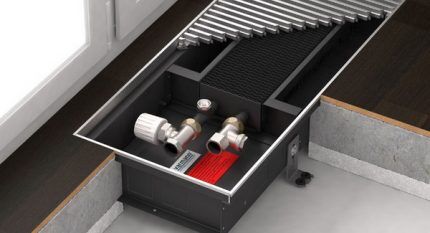
Which type of grating do you prefer?
When choosing a heating device built into the floor, pay special attention to the grille. This element has a decorative role, as it remains above the floor.
The grating can be made of the following materials:
- galvanized, stainless or ordinary steel;
- anodized aluminum;
- natural marble;
- wood - beech, ash, merbau, oak, etc.
When choosing a material, it is necessary to take into account that the system must fit harmoniously into the interior and correspond to the design of the room.
Based on their design, there are 2 types of grilles for in-floor convectors:
- roll — gratings are more expensive and easier to use, since they can be rolled up;
- linear - must be fully raised.
The slats in roll-up grilles are located exclusively across. In a linear design, they are located across and along the heating device.
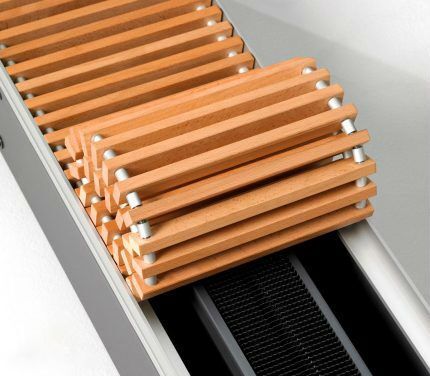
The design of the grate is especially important if people will step on it from above. In this case, you need to pay attention to the appearance and materials used in manufacturing.You should check that the grille does not contain any plastic parts, which manufacturers sometimes use at the junction of the frame and slats.
To evenly distribute the load on the device, reduce noise levels and increase comfort, some manufacturers install springs at the junction of the frame and the lamella.
In conditions of increased load, it is better to choose a grille that has the same design on both sides. If it wears off, it can be turned over for further use.
Features of in-floor water devices
The heating element of water heating devices built into the floor is a hollow tube with pressed or welded plates. Heat transfer is carried out coolant with antifreeze or water. Trench convectors are connected to a common water heating system using threaded pipes.
In built-in water products, the heat exchanger plays an important role. Maximum power is provided by more expensive copper and copper-aluminum heat exchangers. The latter are equipped with a copper pipe and aluminum fins.
Manufacturers also offer budget models made of stainless steel and an economy option made of galvanized steel.
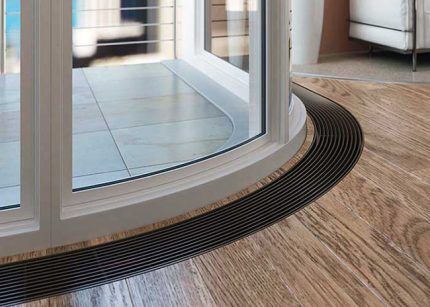
Expensive convectors equipped with copper heat exchangers, in addition to the function of increasing the power of the device, have several disadvantages.
Disadvantages of using such models:
- Copper requires special operating conditions. It is not compatible with some metals from which coolant and grounding devices are made.
- Operating models with heat exchangers made of this metal in a central heating system can cause problems.
But they are suitable for individual heating systems where there is wiring using polymer, metal-polymer or copper pipes. It is better if the heat exchanger of the heating boiler is also made of copper.
Fittings and fittings must be chrome-plated, nickel-plated, brass or bronze.
In addition to water ones, manufacturers offer electric built-in convectors. In them the main role is played by heating element - heating element. It contains plates designed to increase the area of contact of the device with air.
These devices serve as an additional source of thermal radiation in rooms where it is not possible to connect water heating.
Differences between radiator and electric types
In electric and water in-floor heating devices, fans are installed to increase power. This allows you to get much more heat from convectors.
The fans operate on 12, 24 V DC and 220 V AC. To reduce the noise level, they are placed on vibration-proof supports.
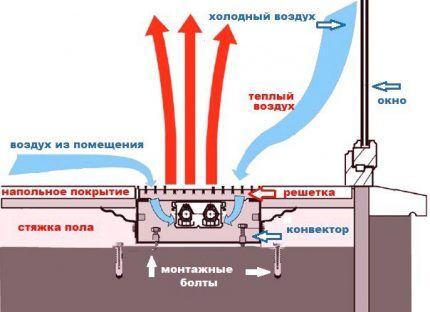
If the owner of the premises plans to use a water in-floor convector as the only or main source of heat, it is recommended to choose models with forced convection. They quickly and efficiently heat the air in the room, preventing condensation from settling on the glass.
Individual models, for example, company products Kermi, can be used not only for heating rooms, but also for cooling them. This happens thanks to the use of 2 separate heat exchange elements connected to different systems - heating and cooling.
There are 2 types of built-in systems - two-pipe and four-pipe. In two-pipe systems, 1 heat exchanger works with 2 systems.
On the modern market there are modifications of in-floor convectors that supply clean and warm air to the room. First, it enters a special hole, then it is cleaned using built-in filters. Then the air is heated, after which it enters the room.
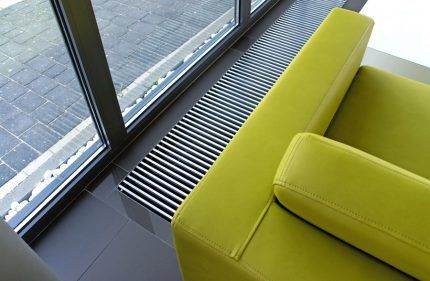
Manufacturers also produce in-floor devices for effective heating of residential, commercial and industrial premises with high humidity levels. In their production, moisture-resistant and modern electrical equipment is used. These models are equipped with a drain to remove accumulated condensate.
Before starting repairs, you can order a convector of a non-standard size, corresponding to the characteristics of the room.
Some manufacturers make rotating heating elements that make cleaning the inside of the case easier. The heat exchanger can be installed on flexible hoses, making it easy to remove for cleaning.
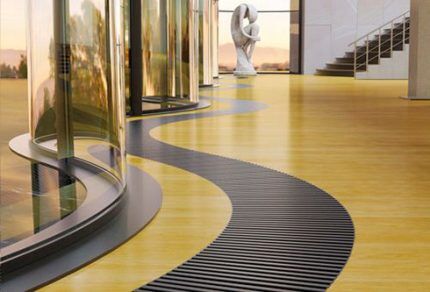
Electronic or electromechanical thermostats are responsible for controlling the temperature and power of the convector.They are located in the device body and are controlled using a remote or remote control. Electronic thermostats allow you to program the temperature by time of day and day of the week.
Rules for choosing a device
When choosing an electric type in-floor convector, the main thing is to evaluate the power and dimensions of the device. It is also advisable to decide on the type of convection, which can be natural and forced.
The choice of water heaters built into the floor requires taking into account many parameters of the functional features of the device.
Main characteristics of the convector
Initially, you need to select the size of the product, the presence of a fan, the material of the housing, fins, and pipes. In addition, you need to pay special attention to other characteristics.
When considering a built-in water-type convector as a home heating device, you should decide on the manufacturer.

One of the most important characteristics of a convector is the type of heating system - single-pipe or two-pipe. Connection diameters do not apply to paramount selection criteria, since there are adapters.
Heating system pressure
This is one of the most important indicators of a water device. Any model is suitable for heating a private house, two-story and three-story cottage, since the pressure in the general heating system is usually no higher than 3 bar.

For high-rise apartments, it is necessary to take into account the pressure testing and working pressure.The operating organization should find out these indicators for your home by comparing them with the characteristics of the selected model.
Selecting a coolant option
When choosing the optimal model of an in-floor convector, it is necessary to take into account the type and parameters of the device. Any model is suitable for individual heating, since the owner of the premises can independently set and control the temperature and characteristics of the coolant.
Residents of high-rise buildings will have to adapt to the conditions and indicators of the water that flows in the sewer pipes. In this case, the following factors should be taken into account: temperature, amount of suspensions, Ph, oxygen content, optimal type of device connection.
Features of installation of an in-floor convector
You can install built-in models of convectors for water-type heating in several ways: by installing the device to the room or to the glass.
If the equipment is turned towards the window, the cold air coming from the window opening will be cut off, which will prevent condensation from occurring. However, the temperature in the room will very slowly reach comfortable values for staying in, since most of the heat will be spent on heating the glass.
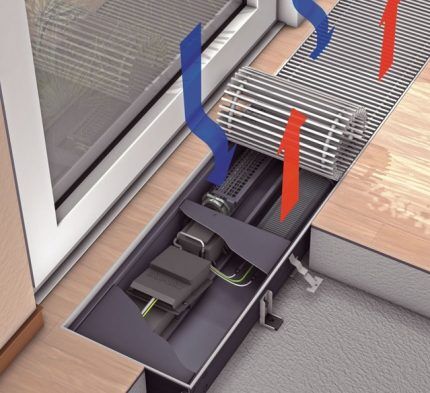
By turning the device towards the room, you can get quick heating. This arrangement may cause condensation to form on the glass. One of the main disadvantages of this method is that there are zones with different temperatures in the room, which create discomfort.
Built-in devices are installed in gutters prepared during the repair process.If the floor in the room is concrete, then the distance between the walls of the gutter and the body of the device is filled with mortar.
When installing the convector in a wooden floor covering, a decorative frame is made around it from beams of identical color.
Advantages and disadvantages of equipment
The modern market offers a huge number of heating devices for floor and wall installation. Universal in-floor devices are especially popular, as they have unique characteristics and advantages.
Disadvantages of built-in devices
The main disadvantage of in-floor structures is their high cost. Their price is several times higher than similar floor-mounted heating devices of the same power.
This is due to the fact that installation of the device is much more complicated than convectors of conventional models.

When installing built-in equipment, the supply pipes must be in the floor. This is a popular solution, difficult from a technical point of view. For hidden installation of the product, it is necessary to raise the floor, which cannot be done in all rooms.
Advantages of in-floor systems
The main advantage of convectors built into the floor is hidden installation, which provides ample opportunities for bold design solutions. This is a suitable option for equipping shop windows and panoramic glazing.

For open, stylish interiors, installing heating units can be a challenge due to lack of space. In most apartments and residential buildings equipped with fashionable panoramic windows, a bulky radiator will not fit into the overall style of the room.
The optimal solution in such situations is a built-in convector. Moreover, you can choose a model with natural or forced convection.
Conclusions and useful video on the topic
Video No. 1. Overview of built-in equipment for water heating:
Video No. 2. Design and installation of in-floor convectors:
Video No. 3. Caring for heating products built into the floor:
The main function of a water convector built into the floor is efficient and fast heating of the room. The equipment protects glass from the formation of condensation - using a thermal curtain, it stops and heats the flow of cold air that constantly emanates from window and door openings.
Depending on the characteristics of the room and the requirements for the product, you can select the optimal model of device.
Those interested in the selection and installation of water in-floor convectors are invited to leave comments and ask questions. The discussion form is located in the lower block.




That’s right, the main function of water convectors is to heat the room quickly and efficiently. This means that there is still no such result as from the good old radiators. And the issue with contamination of the convector is unclear. Dust will accumulate there, and considering that it is located on the floor, there will be a considerable amount of dirt there. How to deal with this, or let everything fly out of it back into the room?
Hello. Trench convectors may or may not have removable heat exchangers. In the second option, practically no dust gets inside, and the outside is quite easy to clean. In the first case, a thorough cleaning after switching off with a regular vacuum cleaner and a damp cloth helps.
We are all accustomed to the fact that apartments and houses usually have batteries. When we started building the house, out of habit we also wanted to install water batteries. It’s good that one smart person advised me to read about in-floor convectors. Cool stuff! It costs more, of course, but you will be happy later. Firstly, these devices do not spoil the interior. Secondly, during operation they are cheaper.
We installed water ones, since electricity is still more expensive. We have large panoramic windows in our hall. I don’t even know where we would put ordinary batteries if we did heating the old fashioned way. For the grille that covers the convector, I advise you to buy a linear one. It's a little more expensive, but it looks nicer. It is easy to assemble. It’s easier to care for, but with a linear one you’ll have a hard time.
Regarding dust, of course it will accumulate in the box. Therefore, we advise everyone to install shut-off valves in front of the heat exchanger inside the box. With their help, it is possible not only to cut off and dismantle the heat exchanger by washing or vacuuming the box, but also to regulate the heat transfer of the convector.
I have an attic house with second light and panoramic windows to the full height. There are doubts whether in-floor convectors can handle heating a room about 6 meters high